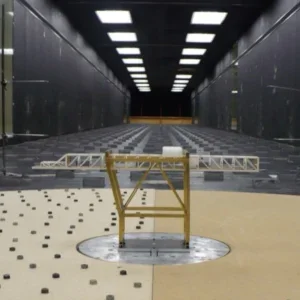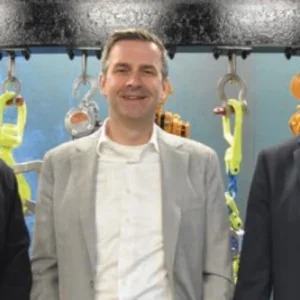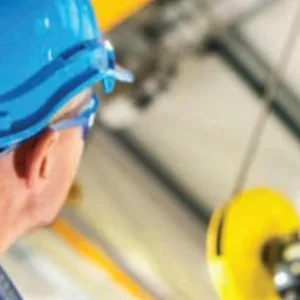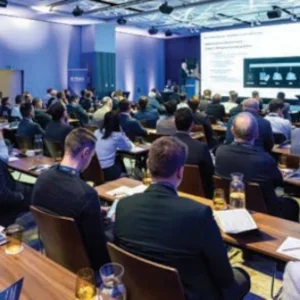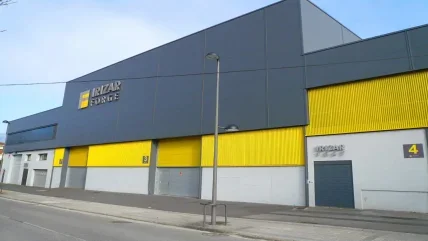
The Spanish foundry Irizar Forge has long been known for the massive hooks, sockets and sheaves it forges from single blocks of metal for the lifting industry, on and off-shore. At the end of last year it announced, as a major goal for 2023, that it would significantly reduce the company’s carbon footprint. To achieve it Irizar had started the process to certification, before 2025, of an energy management system based on the ISO 50001 standard. As an exercise in transparency Irizar has registered this with the relevant Spanish ministry. The company is calling this energy transition project Green Forge. “The aim,” says Oier Sarasola, Irizar’s global offshore sales manager, “is not only to adapt to future legislation on climate change but also to use the opportunity to improve efficiency as a whole, and so increase the competitiveness of our products and services,” so the company’s carbon savings will lead to cost savings as well.
This seems on the surface counterintuitive. A forge by necessity needs a lot of heat, and therefore a lot of energy; for a very large concern such as Irizar to go low-carbon is therefore a considerable challenge and hugely praiseworthy.
A metal-working facility such as Irizar’s needs a large number of overhead cranes. Irizar is based at Lazkao in the Basque Country; Jaso, the large and international crane-making concern is also Basquebased, headquartered in nearby Idiazabal. Irizar Forge is one of the main suppliers of hooks to Jaso. Jaso in return has supplied the Irizar foundry with a fleet of ten overhead cranes for its foundry.
The largest are two 32t double-girder cranes, one of 16.22m span, the other slightly shorter at 14m. Other doublegirder machines range from 6.3t capacity upwards. There is also a 5.0t, 14m span single-girder crane.
Among all of these, the 29.5m, 18t double girder crane stands out. It is part of the forging manipulator, which has the job of handling steel parts at 1,200°C while they are being forged in the presses. The crane also transports parts between the furnaces and the presses. It has been designed therefore to withstand the extreme conditions of a forge.
The crane has a special open trolley.
“The most outstanding feature is the machine’s manoeuvrability in confined spaces, as it can perform simultaneous movements on several axes,” says Jaso’s Antonio Naranjo. “As to capacity, the crane has been designed to withstand the high reactions that are generated due to the fact that the weight of the part to be handled is very far from the vertical axis of the manipulator.”
Further to the south is yet another internationally renowned Spanish hoistand crane maker. GH is headquartered in Barcelona and, like Irizar, has made reducing carbon emissions a key part of its strategy. GH not only manufactures overhead cranes and gantries: boat-lift hoists are also within its remit – we are talking the Mediterranean here, where leisure boating might as well count as an industry – and GH in November 2022 introduced what they say is the world’s first all-electric rubber-tyred gantry boat lift boat lift.
The diesel propulsion system of conventional boat hoists has been replaced by a modular battery system, and the hydraulic circuits that drive the hoist movements now instead have an electric circuit and drives.
The GH70e is powered by a highperformance, lithium-ion battery core – enough onboard storage, GH says, to deliver a full day’s work – and can lift vessels of up to 65 tons. Solar panels are built into the top frame of the gantry – they can supply up to 20% of the daily energy uses, says GH – but there is also a built-in charging device that makes recharging easy. The gantry itself is variable in span, which improves the dry-docking efficiency for boats with different beams. It has electronic steering as well. The battery has a ten-year guarantee.
Ander Etxebarria is director of GH’s e-Motion Business Unit. He regards the launch of the electric marine boat hoist as a worldwide milestone.
“Although there are electric marine boat hoists that have made the transition from hydraulic to electric, there are none with a scale comparable to the one that we have produced,” he says. The GH70e has “all the functionalities that a normal hydraulic marine boat hoist would have, and even some extras”.
“To begin with,” says Etxebarria, “by removing the diesel engine and eliminating CO2 emissions and high noise levels, we also eliminate oil leaks, which are a sensitive issue for boat yard owners since they are companies that work by the sea.”
And the savings from the solar panels are significant: “We have already seen how some customers, after a use of the machine that is not very intensive, have not needed to charge it for several days thanks to the contribution of the panels.”
The GH70e is the first of GH’s electric maritime models, but the company has dry land electric rubber-tyred gantries as well, designed for light industrial use. Again, the power is from lithium-ion batteries with the same ten-year guarantee and built-in charging. Here, the batteries are modular. The gantries come in three versions: single girder, double girder and U-shaped, to provide the flexibility this sector requires. On these dry land versions it is the gantry height, rather than the width, that is adjustable: they have telescopic legs to ease moving equipment into and out of industrial warehouses without emissions or leaks.
SELF-ATTACHING HOOKS
Irizar is not the only major Spanish maker of hooks: Barcelona-based Elebia is also a world leader. Its speciality is in automatic self-attaching hooks – aids to efficiency and also to safety, as they eliminate the need for a human operator to get fingers, hands or any other part of themselves into the danger zone where the hook meets the shackle or load.
Until now, Elebia’s automatic latching systems have been operated magnetically, mechanically by contact with a spring-released probe, or by using the company’s remote control systems eMini, eMax, and eInst.
In January this year, Elebia launched eLink, a central control system for its automatic hooks that can be operated from mobile and smart devices. The innovation is that it is based on the web. It is a huge advantage.
The system is a plug-and-play concept that allows users to automate material handling processes, monitor hook status, conduct remote service, create reports, and oversee lifecycle management. It is installed in the crane panel and features user and password logins, different profiles and access levels, and central data acquisition and control systems. It communicates with the user through a web application interface.
“There are multiple scenarios where controlling hooks via a web-based system is advantageous,” says Oscar Fillol, founder and CEO at Elebia. “For example, you can control all hooks with the same remote control of the crane, or on a multi-hook lift you can block lifting action with the ‘safe lift’ function, which does not allow the load to be lifted if even one of the hooks is not closed. Another common situation where eLink is very useful is in the case of alarm settings: either when a load is unbalanced or when there is an overload.
“It takes an already state-of-the-art lifting portfolio one step further, to facilitate hook control, automation, adjustment of working parameters, and integration with cranes and other devices,” says Fillol. “In short, Elebia products are now Industry 4.0 ready.”
It is compatible with the entire Elebia range of hooks, clamps, grabs and shackles. “It complements the eMini, eMax, and eInst systems; so a customer could be using eMini to send the open/ close instructions while the eLink is used to log the data, avoiding unsafe lifts, and trigger alarms.
“But the aim of the eLink is not to eliminate the user; it is to assist them and make everything easier and safer,” Fillol adds. “ It allows automation and safer lifts, but the user is still needed. He or she must always be able to see the lifting operation. The next step will be adding cameras and expanding beyond eight the number of products that can be connected at the same time.”
Moving eastwards, Italy is renowned for its engineering, and has enough makers of cranes and hoists to fill an article by itself, which is exactly what it shall do, at a later date in this magazine. So, for now, let us move on eastwards again.
Bulgaria has an established cranemaking concern that has been in existence for more than 60 years and that has sold a very large number of units over that time. Podem has its roots back in the 1960s, in the era of the Soviet Union and the Eastern bloc. Back then, of course, its industry was state-controlled. In April 1961, the relevant state ministry decided to build a production company to supply the crane manufacturers in Eastern European countries and the then Soviet Union with electric wire rope hoists. Within the year, Podem started production of its type T hoist. Since then it has sold more than 1,900,000 units, which it says, with probable justification, is the greatest number of a single type ever sold in the world.
In the 1970s, it began selling in Western Europe, the Middle East, Asia, Africa and Latin America, and production capacity reached 100,000 wire rope hoists per year, making it the largest global hoist manufacturer. Today, it has a history of more than two million hoists produced and a footprint in more than 60 markets. Podem has developed a complete range of crane components from a fully renewed production facility and supplies and covers the needs of independent crane manufacturers as well as ownbrand products.
“The past years of the pandemic have been easy for no-one, but despite the difficult times and the rearranged world, Podem has managed to stay focused,” says Miriam Kleytman, Podem’s director of industrial cranes. “We celebrated the company’s 60th birthday in 2021 and by the end of 2022 Podem had achieved its goal of full recovery to the business level of pre- Covid years.”
The company has chosen an individual path: “Many manufacturers opt for standardisation in all their markets,” says Kleytman. “Podem has chosen a different way, more difficult but more rewarding. Instead of offering the same, standardised products to everyone, we cater to the requirements of individual markets; our strong engineering and flexible production planning allow us to do this and we are proud to do so. It is a true challenge, but our manufacturing holds high diversity and standardisation is not a primary goal.
“The range of wire rope hoists that we offer therefore aims to satisfy different needs. Customers can opt for cylindrical or conical motors, two-speed or variable frequency drive control, heavy load twin hoists and open barrel hoisting; these are just some of our products and features.
“Next to our primary goal to be the world’s leading crane component manufacturer, Podem has developed our local industrial crane division where it supplies customised industrial crane solutions. Though our installation arm is restricted to just our neighbouring region we are skilled in crane installations in remote areas, old manufacturing sites, and modernisations. We supply gantry cranes, light crane systems for different applications, and a complete after sales service.”
Kleytman continues: “During the past few years, Podem has created a joint venture facility with EMGR Germany [which designs and supplies drives and drive components] to secure vertical integration for our electric motor supply. A major step will be the forthcoming online crane configurator, a state-of-the-art technology tool to make client’s projects come to life in 3D virtual reality with motion.
“The Podem simulator allows any customer, even one new and lacking knowledge of the crane industry, to automatically select the most suitable technical characteristics – of crane and hoist duty classification, main girder selection and so on – according to his requirements and the latest EN13001 standard. The offer, GA [general arrangement] drawing and even manufacturing drawings are just a click away.
“And we have our newly introduced Podem Datalogger, which improves safety and is also a powerful data monitoring system. It digitally processes the crane’s working cycles and real-time operational information and transforms data into insights to ease operations and maintenance management, and decisionmaking process for the owner.”
Helm Hellas is an international company with subsidiaries in Austria, China, Germany, Poland, the US and the UK and distributors in many other countries. It is firmly based, however, in Korinthos, Greece, where it has been manufacturing for more than 50 years. It is the parent company of Niko, and the Korinthos plant is where Niko equipment is manufactured.
Niko is focused on developing, manufacturing and marketing high-quality track and fittings – it makes track for sliding doors as well as the light crane, conveyor and fall arrest markets and is a well-established player in the UK light crane market.
“In the Mediterranean region, though, it is perhaps in the sliding door sector that we are most known,” says Niko’s Sam Upton. That is about to change. “Niko Cranes SA is a newer subsidiary within the group which was set up to increase our presence in the light crane market across Europe,” says Upton, its managing director.
Its light cranes, he says, are ideal are for lifting solutions up to 2,000kg.
“They can be used for isolated tasks, or on a production line. The Niko track is extremely smooth and free-running. That makes it easy for the customer to move the trolley and also offers accurate positioning. The light cranes are fitted with polyamide wheels, which are more silent than a steel alternative and need a force of less than 1% of the load to set moving.”
Niko can offer anything from a kit of components to a turnkey solution.
“The equipment is often supplied to trade customers who will do their own service and installation. Niko is always looking for new partners and distributors,” says Upton.
“The light crane market did see a dip in 2021, with Covid disruption in many countries and customers seeing lockdowns and isolation periods. But many of the markets recovered in 2022 and turnover is now surpassing pre-Covid figures.”
Expansion, digital technology and carbon footprint reduction are the dominant themes for manufacturers in Southern Europe – themes that seem to be serving them well.
Niko expands in the South
The light crane in the image is at the end of one of Niko’s own production lines. It is used for off-loading equipment from the powder coating conveyor, which handles all the fabricated components of the firm’s lifting products: light cranes reinforcements, bridges, jib cranes, the freestanding steelwork and much more. It is also used to help get the equipment packaged for shipping.
The crane shown is a 1.0-ton safe working load hoist on a 9x9m with supports in four corners.
“The Niko system can span up to 10m and lift 2,000kg with this type of ladder reinforcement. Having less steelworks gives a greater working area and fewer obstructions,” says Sam Upton, MD of Niko Cranes SA, a newer subsidiary within the group that was set up to increase Niko’s presence in the light crane market across Europe.


